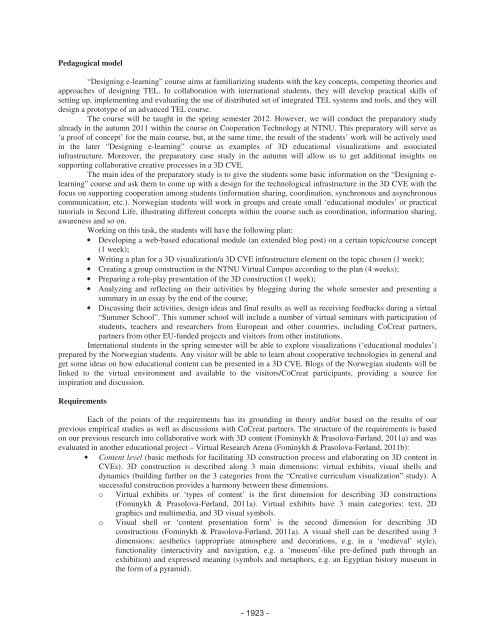Disputation Mikhail Fominykh - Department of Computer and ...
Disputation Mikhail Fominykh - Department of Computer and ...
Disputation Mikhail Fominykh - Department of Computer and ...
You also want an ePaper? Increase the reach of your titles
YUMPU automatically turns print PDFs into web optimized ePapers that Google loves.
Pedagogical model<br />
“Designing e-learning” course aims at familiarizing students with the key concepts, competing theories <strong>and</strong><br />
approaches <strong>of</strong> designing TEL. In collaboration with international students, they will develop practical skills <strong>of</strong><br />
setting up, implementing <strong>and</strong> evaluating the use <strong>of</strong> distributed set <strong>of</strong> integrated TEL systems <strong>and</strong> tools, <strong>and</strong> they will<br />
design a prototype <strong>of</strong> an advanced TEL course.<br />
The course will be taught in the spring semester 2012. However, we will conduct the preparatory study<br />
already in the autumn 2011 within the course on Cooperation Technology at NTNU. This preparatory will serve as<br />
‘a pro<strong>of</strong> <strong>of</strong> concept’ for the main course, but, at the same time, the result <strong>of</strong> the students’ work will be actively used<br />
in the later “Designing e-learning” course as examples <strong>of</strong> 3D educational visualizations <strong>and</strong> associated<br />
infrastructure. Moreover, the preparatory case study in the autumn will allow us to get additional insights on<br />
supporting collaborative creative processes in a 3D CVE.<br />
The main idea <strong>of</strong> the preparatory study is to give the students some basic information on the “Designing e-<br />
learning” course <strong>and</strong> ask them to come up with a design for the technological infrastructure in the 3D CVE with the<br />
focus on supporting cooperation among students (information sharing, coordination, synchronous <strong>and</strong> asynchronous<br />
communication, etc.). Norwegian students will work in groups <strong>and</strong> create small ‘educational modules’ or practical<br />
tutorials in Second Life, illustrating different concepts within the course such as coordination, information sharing,<br />
awareness <strong>and</strong> so on.<br />
Working on this task, the students will have the following plan:<br />
• Developing a web-based educational module (an extended blog post) on a certain topic/course concept<br />
(1 week);<br />
• Writing a plan for a 3D visualization/a 3D CVE infrastructure element on the topic chosen (1 week);<br />
• Creating a group construction in the NTNU Virtual Campus according to the plan (4 weeks);<br />
• Preparing a role-play presentation <strong>of</strong> the 3D construction (1 week);<br />
• Analyzing <strong>and</strong> reflecting on their activities by blogging during the whole semester <strong>and</strong> presenting a<br />
summary in an essay by the end <strong>of</strong> the course;<br />
• Discussing their activities, design ideas <strong>and</strong> final results as well as receiving feedbacks during a virtual<br />
“Summer School”. This summer school will include a number <strong>of</strong> virtual seminars with participation <strong>of</strong><br />
students, teachers <strong>and</strong> researchers from European <strong>and</strong> other countries, including CoCreat partners,<br />
partners from other EU-funded projects <strong>and</strong> visitors from other institutions.<br />
International students in the spring semester will be able to explore visualizations (‘educational modules’)<br />
prepared by the Norwegian students. Any visitor will be able to learn about cooperative technologies in general <strong>and</strong><br />
get some ideas on how educational content can be presented in a 3D CVE. Blogs <strong>of</strong> the Norwegian students will be<br />
linked to the virtual environment <strong>and</strong> available to the visitors/CoCreat participants, providing a source for<br />
inspiration <strong>and</strong> discussion.<br />
Requirements<br />
Each <strong>of</strong> the points <strong>of</strong> the requirements has its grounding in theory <strong>and</strong>/or based on the results <strong>of</strong> our<br />
previous empirical studies as well as discussions with CoCreat partners. The structure <strong>of</strong> the requirements is based<br />
on our previous research into collaborative work with 3D content (<strong>Fominykh</strong> & Prasolova-Førl<strong>and</strong>, 2011a) <strong>and</strong> was<br />
evaluated in another educational project – Virtual Research Arena (<strong>Fominykh</strong> & Prasolova-Førl<strong>and</strong>, 2011b):<br />
• Content level (basic methods for facilitating 3D construction process <strong>and</strong> elaborating on 3D content in<br />
CVEs). 3D construction is described along 3 main dimensions: virtual exhibits, visual shells <strong>and</strong><br />
dynamics (building further on the 3 categories from the “Creative curriculum visualization” study). A<br />
successful construction provides a harmony between these dimensions.<br />
o Virtual exhibits or ‘types <strong>of</strong> content’ is the first dimension for describing 3D constructions<br />
(<strong>Fominykh</strong> & Prasolova-Førl<strong>and</strong>, 2011a). Virtual exhibits have 3 main categories: text, 2D<br />
graphics <strong>and</strong> multimedia, <strong>and</strong> 3D visual symbols.<br />
o Visual shell or ‘content presentation form’ is the second dimension for describing 3D<br />
constructions (<strong>Fominykh</strong> & Prasolova-Førl<strong>and</strong>, 2011a). A visual shell can be described using 3<br />
dimensions: aesthetics (appropriate atmosphere <strong>and</strong> decorations, e.g. in a ‘medieval’ style),<br />
functionality (interactivity <strong>and</strong> navigation, e.g. a ‘museum’-like pre-defined path through an<br />
exhibition) <strong>and</strong> expressed meaning (symbols <strong>and</strong> metaphors, e.g. an Egyptian history museum in<br />
the form <strong>of</strong> a pyramid).<br />
- 1923 -
















